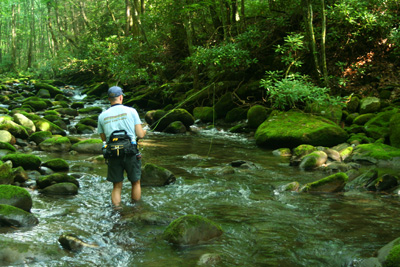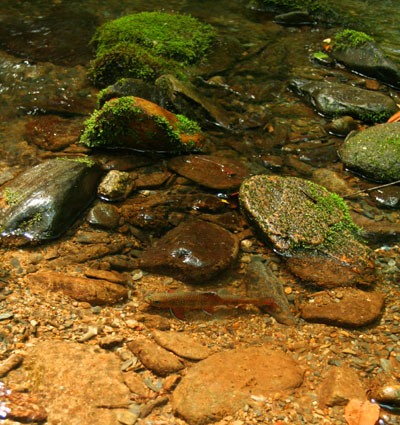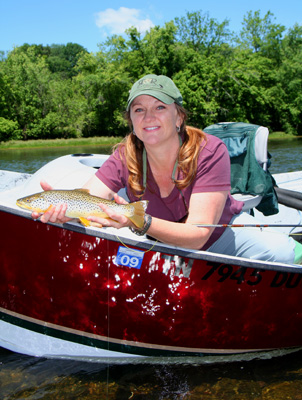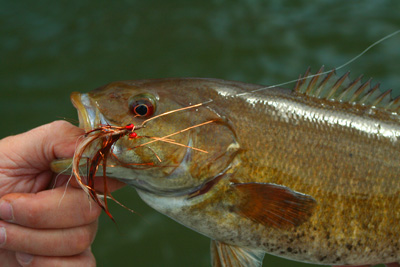Fly fishing on the rivers of East Tennessee and the streams of the Smoky Mountains has been excellent this spring. Our fisheries seem to have only suffered minimal impacts from last year’s drought and water levels are excellent this year. Tailwater fishing was as good as we’ve seen it this spring. We’ve already moved into the heat of summer and are getting into the groove of warm weather fishing. We’re been wading wet in the Smokies for several weeks and expect to continue with that until early October or late September.
Head into the back country for the best summer fishing
Smoky Mountain Streams
Summer always sees us migrating to the higher elevations in the summer to pursue trout. While there are plenty of fish around Metcalf Bottoms on Little River, these fish are always somewhat sluggish in the hot months. We generally go upstream of Elkmont or fish other streams at elevation such as the West Prong of the Little Pigeon River, the Oconaluftee River, and Porters Creek. While all of these streams are often harder to wade than Little River, there is always much more action.
Brook trout are often one of our main summer time targets in the Smokies. There are found in streams that always flow cold plus their aggressive strikes make for a great day on the water. Again, these streams can be rought to wade in many places, but it’s well worth the effort for anyone who wants to catch some beautiful trout in an incredible setting.
Head to the high country to find brook trout…
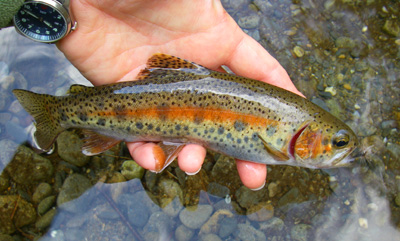
…and rainbows too!
General attractor patterns work well in secluded mountain streams, but be sure to bring some terrestrial fly patterns along as well. Ants, beetles, and inch worms are all extremely effective in the hot summer months and will often out fish commonly used attractors in more pressured streams.
Be sure to get out after thunderstorms as well. These short but intense periods of rain, common during the summer months in the Smokies, provide some superb fishing. Nymphs are often the best fly patterns. We like Prince and Tellico Nymphs in #10-12. Be sure to try some streamers as well. Black or Brown Woolly Buggers in #8-10 are great but tie on a #2-6 Zuddler for big pools on larger streams like Little River, Deep Creek, and the Oconaluftee River.
Tailwater Rivers
Floats for trout are generally less productive in the summer than the spring on the Clinch and Holston Rivers. However, we still catch some fish. Flows are often less predictable in the summer than they are in the spring so we will usually finalize plans for a float the night before. Most of the fishing is done with small nymphs, but there are often some dry fly opportunities. Stripping streamers with a sink tip or full sink fly line is one of our favorite methods on the tailwaters. This is always more work for the angler, but the average trout is always larger.
We’ll still see a few caddis on the Holston and midges are a constant on the Clinch. Be sure to keep tabs on generation schedules for the Hiwassee, South Holston, and Watauga. All of these tailwaters continue to fish well through the summer. Some of the best Sulphur hatches in the nation take place on the South Holston. Summer is an excellent time for beetles on the Watauga. Anglers can usually wade the Hiwassee in the morning before the generators come on. Fish midges, small caddis, and bead heads to stay in fish.
There are still some nice trout yet to be caught from the drift boat this summer
Fly Fishing for Smallmouth Bass
We’ve already cast some streamers and poppers for smallmouth bass on the rivers. The Holston, Pigeon, and Little River are all places we frequent when we’re looking for bronze backs. Smallies are the red-headed step child of the fly fishing world, but we’re trying to change that. Last summer we introduced a number of our customers to fly fishing for smallmouth bass and everyone loved it. While conditions for trout are often less than favorable in the summer they can be perfect for river smallies. We prefer to fish on the surface with poppers, but will often cast streamers as well. The fish we catch are generally as long or longer than the trout we catch, but heavier and usually fight harder. The rivers we float are every bit as scenic as the rivers we float for trout and most of the fishing is visual so you see the strike.
If you’re heading out on your own you can probably find any number of quality rivers and streams to catch smallies. In Western North Carolina be sure to check out the French Broad, Tuckaseegee, Little Tennessee, and Cheoah Rivers. In East Tennessee look at the Pigeon, Little Pigeon, Nolichucky, Holston, Powell, and lower Tellico Rivers.
Our favorite flies are “chugger” style poppers that make lots of racket in #6-8 as well as Sneaky Petes. If you can’t get the bass to look up, try a basic Woolly Bugger in #6-10. Brown and orange Clouser Minnows fish extremely well in riffles and pockets.
